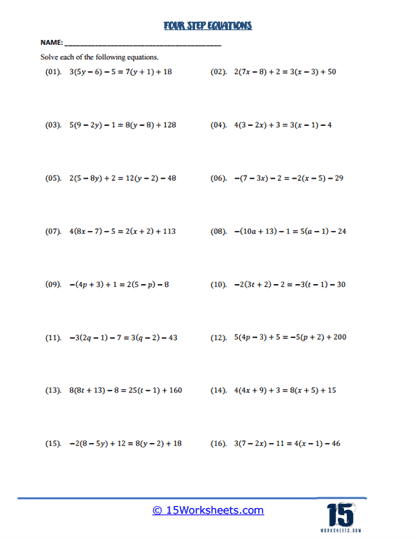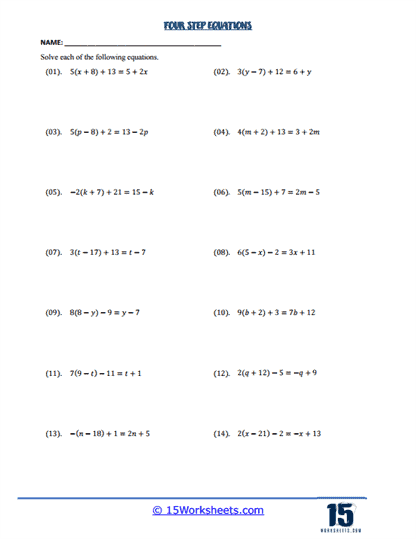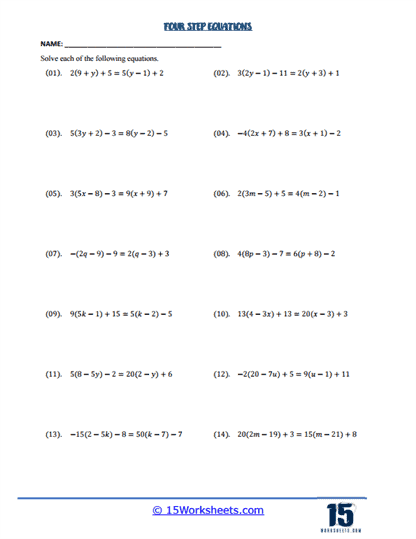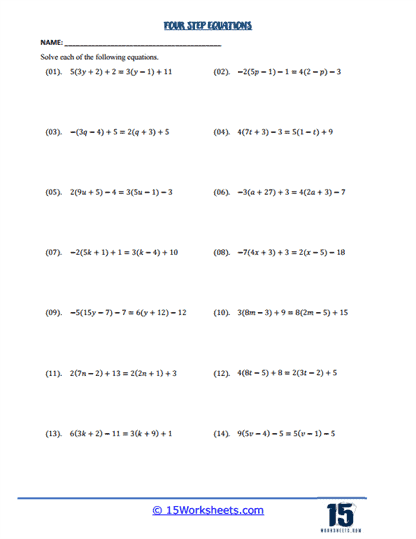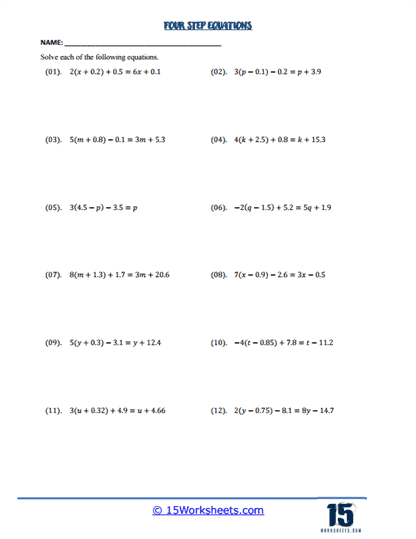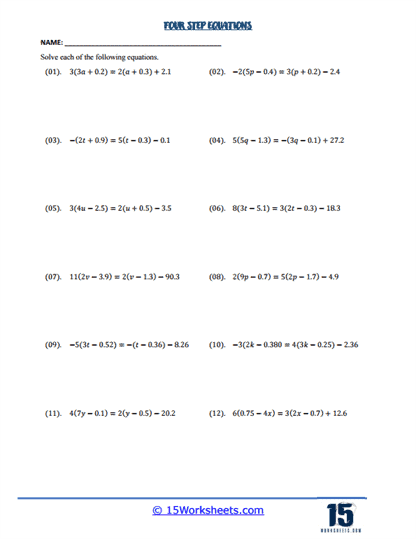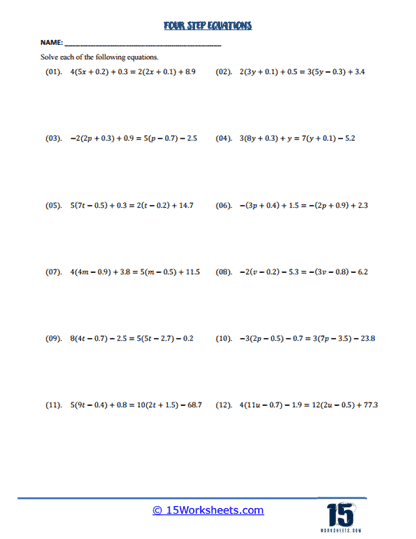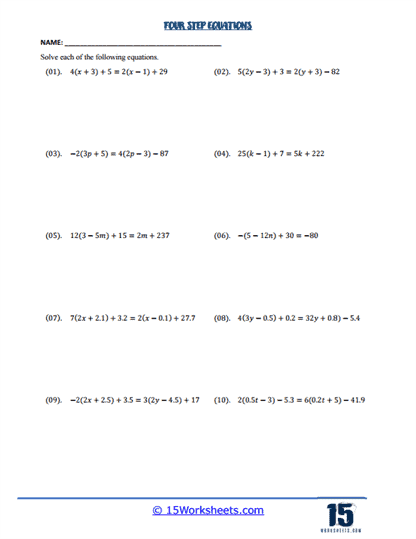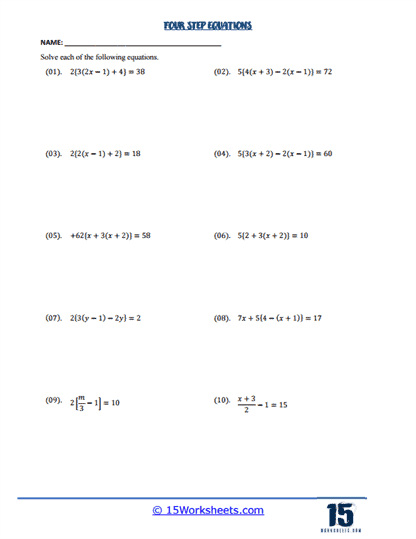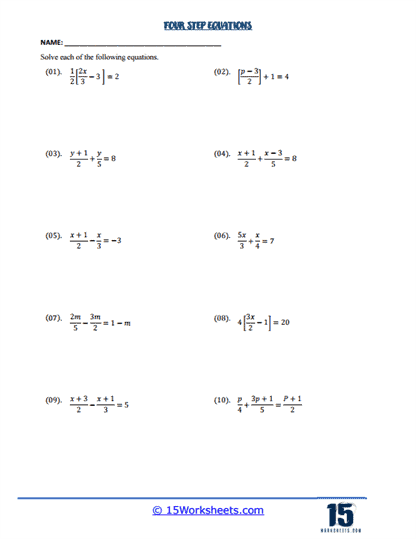Four Step Equations Worksheets
About These 15 Worksheets
These worksheets can really help a great deal when it comes to teaching and reinforcing algebraic problem-solving skills, particularly for students who are transitioning from simple arithmetic to more complex algebraic concepts. These worksheets are designed to guide students through the process of solving equations that require multiple steps to isolate the variable and determine its value. Each worksheet typically features a variety of problems that challenge students to apply different algebraic techniques in a structured manner, ensuring a comprehensive understanding of the material.
The core concept behind these worksheets is to provide students with practice in solving equations that involve four distinct steps. These steps usually include distributing, combining like terms, moving variables to one side of the equation, and isolating the variable. This sequence of operations is essential for students to master, as it forms the foundation for solving more complex equations they will encounter in higher-level math courses.
In the first type of worksheet, students might encounter problems that require them to apply the distributive property as the initial step. For instance, an equation might begin with a term like 5(x + 1), which students need to expand to 5x + 5. This is followed by combining like terms on both sides of the equation, which reinforces their understanding of simplifying algebraic expressions. The next step typically involves moving all terms involving the variable to one side of the equation and all constant terms to the other side. This step is crucial in teaching students how to manipulate equations effectively. Finally, students must isolate the variable by performing the appropriate arithmetic operations, such as division or multiplication.
Another common type of worksheet focuses on equations that require students to work with both positive and negative integers. These worksheets challenge students to maintain accuracy while managing the signs of the numbers involved. For example, they might be required to solve an equation like 3(x – 4) + 2 = 5x – 8. Here, students need to carefully distribute the 3, then move the 5x term to one side while moving the constants to the other. The process reinforces their understanding of how to handle subtraction and addition of negative numbers, which is a critical skill in algebra.
Some worksheets introduce equations that involve fractions, adding another layer of complexity. For instance, an equation might require students to first clear fractions by multiplying all terms by the least common denominator (LCD). This not only helps in eliminating fractions but also prepares students for future problems involving rational expressions. After clearing the fractions, students proceed with the usual steps of solving the equation. These types of problems are excellent for teaching students how to handle fractions within an algebraic context, a skill that is often challenging for many learners.
There are worksheets that incorporate variables on both sides of the equation. These types of problems are particularly useful for teaching students how to manage equations where they must first simplify both sides before proceeding with the usual steps. For example, an equation might look like
4(x + 2) = 2x + 8. Here, students need to distribute on both sides, combine like terms, and then isolate the variable. This reinforces their ability to work systematically through more complex algebraic equations.
More advanced worksheets might include equations that involve decimals. These problems are designed to test students’ precision with decimal arithmetic while also reinforcing their understanding of the four-step process. For example, an equation might require students to solve 2.5x + 0.5 = 1.5x + 3. The challenge here lies in correctly aligning decimal points and performing operations with decimals, all while keeping track of the steps involved in solving the equation.
A variation of these worksheets might present students with problems where the equation involves multiple operations, such as 5(2x – 3) = 4x + 7. These problems require students to apply their knowledge of the order of operations, as they must first simplify inside the parentheses, then distribute, and finally solve for the variable. These types of problems are excellent for reinforcing the sequence of operations and ensuring that students understand how to approach multi-step problems systematically.
Some of the worksheets include word problems that require setting up and solving four-step equations. These problems are particularly valuable because they help students apply their algebraic skills in real-world contexts. For example, a problem might describe a scenario where a certain number of items are added or subtracted from a total, and students must set up an equation to solve for the unknown quantity. This type of problem-solving is crucial for developing students’ abilities to translate real-world situations into mathematical equations and then solve them.
You will find problems that require students to check their solutions by substituting the variable back into the original equation. This step is important because it teaches students to verify their work and ensures that they understand the relationship between the solution and the original problem. It also reinforces the concept that solving an equation is not just about finding a number, but about finding a number that makes the original equation true.
These exercises are not just about practicing specific algebraic techniques; they are about developing a deeper understanding of how to approach and solve complex problems in a methodical way. By working through these problems, students learn to break down an equation into manageable parts, tackle each part systematically, and ultimately solve for the variable. This process helps build their confidence and prepares them for more advanced math topics.
This collection of worksheets are designed to cater to a range of difficulty levels, making them suitable for a wide variety of learners. For beginners, the problems might be more straightforward, involving simple integers and basic operations. As students become more comfortable with the material, the worksheets increase in complexity, introducing variables on both sides, fractions, decimals, and word problems. This gradual increase in difficulty helps ensure that students are continually challenged without being overwhelmed, allowing them to build their skills progressively.
In the classroom, these worksheets can be used in a variety of ways. Teachers might use them as part of a lesson on solving equations, guiding students through the first few problems as a class before allowing them to work independently. Alternatively, these worksheets can be assigned as homework or used in small group settings where students can collaborate and discuss different approaches to solving the problems. They can also be used as assessment tools, allowing teachers to gauge students’ understanding of the material and identify areas where additional instruction might be needed.






